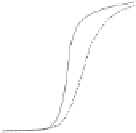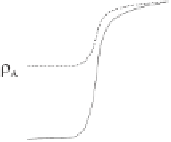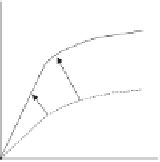Information Technology Reference
In-Depth Information
φ
Α
ψ
Α
(a) modify
C
(c) modify
L
(b) modify
T
φ
Α
ψ
Α
(e) modify
C
(d) modify
L
Figure 4.19
Modifications to specific stages in the inversion process: (a) reducing
the repressor/operator binding affinity; (b) reducing the strength of the promoter;
(c) reducing the strength of the ribosome binding site; (d) increasing the cistron count;
(e) adding autorepression.
result in different behaviors for each repressor/operator pair. Figure 4.20 shows
BioSPICE simulations where hypothetical reductions in the repression affinity
of
cI
to O
R
1 shift the overall transfer function of the
cI
/P(R) inverter outward.
In these simulations, the original values of
k
rprs(a
2
)
and
k
rprs(a
4
)
were scaled
down by factors of 10, 100, and 1000. Chapter 7 reports experimental transfer
functions results where the affinity of
cI
to the
promoter is modified by
mutating base pairs on OR
1
. The experimental results demonstrate the desired
shift outward.
λ
MODIFYING THE STRENGTH OF THE PROMOTER Certain basepair mutations at
the promoter site alter the affinity of the RNA polymerase to the promoter. DNA
sequence determinants of promoter strengths have been studied extensively [2,
14, 17]. As illustrated by Figure 4.19b, weakening a promoter shifts
T
, the
transcription-stage mapping between
ρ
A
and
ψ
Z
, inward. Any given level of
the active promoter (the complement of
ρ
A
) now results in less transcription and



















